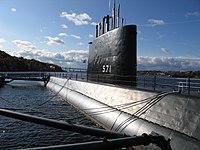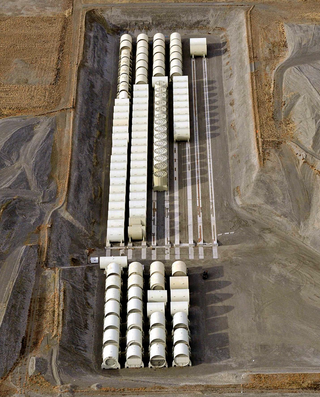
United States naval reactors are nuclear reactors used by the United States Navy aboard certain ships to generate the steam used to produce power for propulsion, electric power, catapulting airplanes in aircraft carriers, and a few minor uses. Such naval nuclear reactors have a complete power plant associated with them. All commissioned U.S. Navy submarines and supercarriers built since 1975 are nuclear powered, with the last conventional carrier, USS Kitty Hawk, being decommissioned in May 2009. The U.S. Navy also had nine nuclear-powered cruisers with such reactors, but they have since been decommissioned also.
General Dynamics Electric Boat (GDEB) is a subsidiary of General Dynamics Corporation. It has been the primary builder of submarines for the United States Navy for more than 100 years. The company's main facilities are a shipyard in Groton, Connecticut, a hull-fabrication and outfitting facility in Quonset Point, Rhode Island, and a design and engineering facility in New London, Connecticut.

Naval Submarine Base New London is the primary United States Navy East Coast submarine base, also known as the "Home of the Submarine Force." It is located in Groton, Connecticut directly across the Thames River from its namesake city of New London.

USS Holland (SS-1) was the United States Navy's first submarine, although not its first underwater watercraft, which was the 1775 submersible Turtle. The boat was originally laid down as Holland VI at the Crescent Shipyard of Elizabeth, New Jersey for John Philip Holland's Holland Torpedo Boat Company, and launched on 17 May 1897. She was acquired by the USN on 11 April 1900 and commissioned on 12 October 1900, Lieutenant H. H. Caldwell commanding.

X-1 was a United States Navy Midget Submarine designed under project SCB 65. Laid down on 8 June 1954, at Deer Park, Long Island, New York, by the Engine Division of Fairchild Engine and Airplane Corporation. Launched on 7 September 1955, at Oyster Bay, Long Island, by Jakobson Shipyard. Delivered to the Navy on 6 October at New London, Connecticut and placed in service on 7 October 1955 with Lieutenant Kevin Hanlon in command.

USS Nautilus (SSN-571) was the world's first operational nuclear-powered submarine and on 3 August 1958 became the first submarine to complete a submerged transit of the North Pole. Her initial commanding officer was Eugene "Dennis" Wilkinson, a widely respected naval officer who set the stage for many of the protocols of today's Nuclear Navy of the US, and who had a storied career during military service and afterwards.

USS Triton (SSRN/SSN-586), the only member of her class, was a nuclear powered radar picket submarine in the United States Navy. She had the distinction of being the only Western submarine powered by two nuclear reactors. Triton was the second submarine and the fourth vessel of the United States Navy to be named for the Greek god Triton. At the time of her commissioning in 1959, Triton was the largest, most powerful, and most expensive submarine ever built at $109 million excluding the cost of nuclear fuel and reactors.
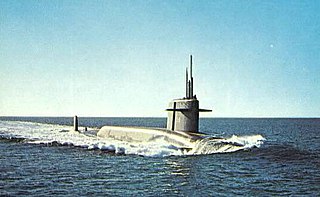
USS Thomas A. Edison (SSBN-610), an Ethan Allen-class nuclear-powered ballistic missile submarine, was the second ship of the United States Navy to be named for the inventor Thomas Edison (1847–1931).

Turtle was the world's first submersible vessel with a documented record of use in combat. It was built in 1775 by American David Bushnell as a means of attaching explosive charges to ships in a harbor, for use against the Royal Navy during the American Revolutionary War. Connecticut Governor Jonathan Trumbull recommended the invention to George Washington, who provided funds and support for the development and testing of the machine.

David Bushnell , of Westbrook, Connecticut, was an American inventor, a patriot, a teacher, and a medical doctor.

Intelligent Whale is an experimental hand-cranked submarine developed for potential use by the United States Navy in the 1860s.

Groton is a town in New London County, Connecticut located on the Thames River. It is the home of General Dynamics Electric Boat, which is the major contractor for submarine work for the United States Navy. The Naval Submarine Base New London is located in Groton, and the pharmaceutical company Pfizer is also a major employer. Avery Point in Groton is home to a regional campus of the University of Connecticut. The town is part of the Southeastern Connecticut Planning Region. The population was 38,411 at the 2020 census.
There are three major types of submarines in the United States Navy: ballistic missile submarines, attack submarines, and cruise missile submarines. All submarines currently in the U.S. Navy are nuclear-powered. Ballistic missile submarines have a single strategic mission of carrying nuclear submarine-launched ballistic missiles. Attack submarines have several tactical missions, including sinking ships and subs, launching cruise missiles, and gathering intelligence. Cruise missile submarines perform many of the same missions as attack submarines, but with a focus on their ability to carry and launch larger quantities of cruise missiles than typical attack submarines.

The United States Navy (USN)'s sixteen O-class coastal patrol submarines were built during World War I and served the USN from 1918 through the end of World War II.

The Royal Navy Submarine Museum at Gosport is a maritime museum tracing the international history of submarine development from the age of Alexander the Great to the present day, and particularly the history of the Royal Navy Submarine Service from the navy's first submarine, Holland 1, to the nuclear-powered Vanguard-class submarines. The museum is located close to the former shore establishment HMS Dolphin, the home of the Royal Navy Submarine Service from 1904 until 1999.
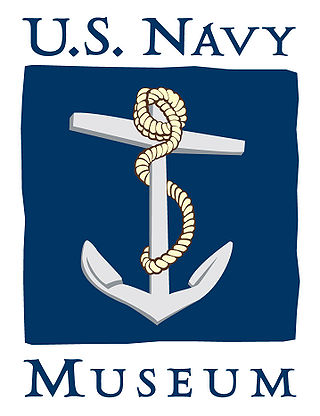
The National Museum of the United States Navy, or U.S. Navy Museum for short, is the flagship museum of the United States Navy and is located in the former Breech Mechanism Shop of the old Naval Gun Factory on the grounds of the Washington Navy Yard in Washington, D.C., United States.
The S2W reactor was a naval reactor built by Westinghouse used by the United States Navy to provide electricity generation and propulsion on warships.
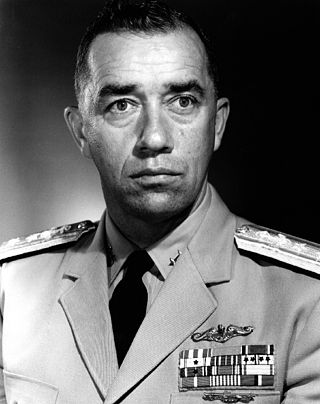
Eugene Parks "Dennis" Wilkinson was a United States Navy officer. He was selected for three historic command assignments. The first, in 1954, was as the first commanding officer of USS Nautilus, the world's first nuclear-powered submarine. The second was as the first commanding officer of USS Long Beach, America's first nuclear surface ship. The third was in 1980 when he was chosen as the first President and CEO of the Institute of Nuclear Power Operations (INPO) from which he retired in 1984.
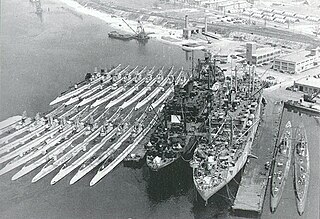
Atlantic Reserve Fleet, New London opened in 1946 at the Naval Submarine Base New London in Groton, Connecticut on the Thames River. The New London Reserve Fleet was 3 miles north of the city New London, Connecticut. Naval Submarine Base New London opened in 1872 as a Navy yard, gained its first submarines on 13 Oct 1915, and earned the designation of Submarine Base in about 1916. The freshwater port became a good site to store both submarines and ships after World War II as part of the United States Navy reserve fleets. Three submarine tender ships were given the task of mothballing the submarines. The three ships: USS Apollo, USS Anthedon, USS Proteus (AS-19) cleaned the ship and sealed the subs with preservatives. It took a few years to process the over 50 submarines in the New London Reserve fleet. Some submarines there were reactivated for the Korean War. By 1965 the fleet of World War II submarine were obsolete and the fleet had been scrapped.




